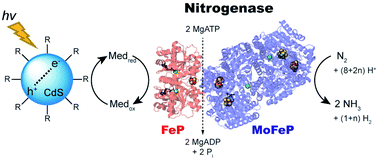Tailoring electron transfer pathway for photocatalytic N2-to-NH3 reduction in a CdS quantum dots-nitrogenase system†
Abstract
The combination of abiotic photosensitizers with purified enzymes in a biohybrid system offers a promising pathway to utilizing light to accomplish challenging chemical transformations and provides insights into the rational photocatalytic system design for efficient solar-to-chemical energy conversion. In this work, we demonstrate a hybrid photocatalytic system for ammonia production from N2 by combining cadmium sulfide quantum dots (CdS QDs) and Mo-nitrogenase from Azotobacter vinelandii, composed of the iron protein (FeP) and the molybdenum-iron protein (MoFeP). Photoexcited electrons from the CdS QD are delivered by an electron transfer mediator through the FeP to the catalytic MoFeP. The complete system was optimized for the ligand on the CdS QDs, mediators, and reaction conditions. The best results were achieved with β-mercaptoethanol as a QD ligand. The mediator test revealed that 1,1′-bis(3-sulfonatopropyl)-4,4′-bipyridinium (SPr)2V (−0.4 V vs. NHE) supports the reduction of protons and N2 to H2 and ammonia catalyzed by nitrogenase. However, in the presence of 1,1′-trimethylene-2,2′-bipyridinium TQ (−0.54 V vs. NHE) as a mediator, nitrogenase catalysis resulted in remarkably more products. The UV-vis and in situ potentiometric studies revealed that better performance with TQ is achieved due to the significantly more negative solution potential allowing for efficient reduction of FeP. As a result, the quantum yield for conversion of absorbed photons to ammonia attains 16%, far exceeding that of previously reported nitrogenase-based systems. This work reveals the importance of tuning the electron transfer pathways in photocatalytic systems and illustrates a potent strategy for efficient electronic coupling of a photosensitizer and an N2 reduction catalyst.



 Please wait while we load your content...
Please wait while we load your content...